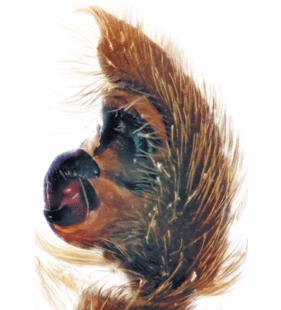Pardosa azerifalcata Marusik, Guseinov & Koponen, 2003
Description
Male
Black cymbium covered with black setae. Tegular apophysis large with two well developed arms. Embolus base wide, subdivided by furrow in two parts, tip of embolus slightly turned. Terminal apophysis subdivided in two parts: one large bill shaped an another small one. Palea with distinct ridge. Shape of palea, terminal apopyhsis, tegular apophysis and embolus specific. Basal part of embolus very thin and embolus curved.
Coloration dark. Carapace length 3.0-3.4 mm, 2.3-2.5 mm wide, dark brown, eye field black, yellow-brown band distinct in thoracic part only, lateral light stripes broken. Chelicerae dark brown. Sternum, labium and gnathocoxae gray. Sternum with light spot in anterior part.
Legs light yellow with light gray spots. Metatarsus with four ventral spines; metatarsi I-II with two retrolateral spines.
Dorsum gray with small sparse yellow spots, venter yellow with gray anterior part.
Body length male: 5.5-5.6 mmFemale
Epigynal septum long and thin, its apical part long, receptaculae thin. Width of basal septum part (free part) is equal in width to septal stem. Pockets untouched, fovea partly visible.
Carapace 3.4-3.5 mm long, 2.6-2.8 mm wide, median band lighter and wider than in male, lateral light stripes penetrate to cephalic part. Sternum with dense light setae and median band along almost the whole sternum. Gnathocoxae and chelicerae yellow.
Leg spination as in male, annulation more distinct and darker than in male.
Dorsum pattern formed by larger and more distinct yellow spots than in the male. Venter light gray.
Body length female: 8.3 mmAdditional information
Sibling species of P. jergeniensis.
Distribution
Phenology
| Jan | Feb | Mar | Apr | May | Jun | Jul | Aug | Sep | Oct | Nov | Dec |
 |  |
Figures
Distribution List
"No references" does not mean that the species does not occur in this country, but that we have not yet inserted the reference for it. We are working on it.
References
Marusik Y M, Guseinov E F, Koponen S (2003a) A survey of east Palaearctic Lycosidae (Araneae). I. On three closely related species of the Pardosa falcata-group. Acta Arachnologica 52: 43-50 ![]()
Otto S (2022) Caucasian spiders. A faunistic database on the spiders of the Caucasus Ecoregion. Database version 02.2022. Internet: caucasus-spiders.info.
WSC (2024) World Spider Catalog. Version 25.5. Natural History Museum Bern, online at http://wsc.nmbe.ch (31.10.2024) doi: 10.24436/2 ![]()
Zamani A, Nadolny A A, Esyunin S L, Marusik Y M (2022a) New data on the spider fauna of Iran (Arachnida: Araneae), part IX. Arachnology 19: 358-384 ![]()











